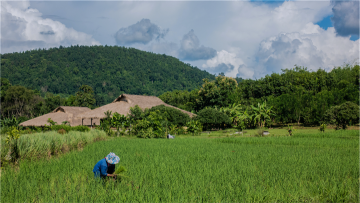
More than $750 billion a year in additional global investment in nature will be needed to achieve the Sustainable Development Goals (SDGs) by 2030, according to the latest research by the Green Growth Knowledge Partnership (GGKP) and the Basque Centre for Climate Change (BC3).
Leading experts taking part in a GGKP webinar on 6 July outlined solutions to plug this investment gap, and how policymakers and businesses can value risks and identify financing opportunities for enhancing natural capital and building sustainable economic growth.
Anil Markandya, with the Basque Centre for Climate Change (BC3) and a lead author of an initial study of the issue, said that based on a global average, the greatest return on investment from increasing natural capital comes from financing wetland restoration. The findings indicate that for every $1 spent on land remediation, $391 is generated in in natural capital benefits.
Markandya called on policymakers to compare current investments to identify financing gaps and to identify actions for mobilizing finance and prioritizing natural capital-related SDGs in development policy.
“What is ultimately needed is a fundamental shift in economic and financial systems,” said Janez Potočnik, Co-Chair of the International Resource Panel (IRP) and a former European Commissioner for Science and Research, and for the Environment. “We need to account for nature through value – the systems currently do not recognize the value of natural assets and the services they provide and are not incentivizing actors to use finite resources sustainably.”
Potočnik and fellow IRP Co-Chair Izabella Teixeira recently issued science-based natural resource management principles to help mitigate environmental risks. The principles support policymakers in moving beyond pledges and commitments and towards approaches to natural resource management that acknowledge, understand and address the direct and indirect drivers of biodiversity loss for climate, nature, and just economic and social development.
Mobilizing financial innovation and products for natural capital
Elizabeth M. White, responsible for the International Finance Corporation’s global sustainability strategy, outlined three ways the private sector can contribute to enhancing and preserving natural capital: scale financing innovations, such as sustainability-oriented bonds; integrate natural capital accounting into governance structures; and spotlight examples of leaders who are doing this work to demonstrate the market case for sustainability.
The Chair of the Finance for Biodiversity (F4B) Initiative and technical expert group Co-Chair of the Taskforce on Nature-related Financial Disclosures (TNFD), Simon Zadek, explained: “What we’re trying to do at scale is to align global finance with nature-positive outcomes. That has less to do with mobilization and more to do with changing the rules of the game.” He noted that, to do so, new rules of the game need to be passed – be it financial regulation, litigation, or changing consumer behavior – to shift financial resources away from nature-destructive assets from production to nature-positive assets from production.
Ivo Mulder, Head of the Climate Finance Unit at the United Nations Environment Programme (UNEP), pointed to practical examples for nature-positive financing. One can reduce trade-related tariffs on sustainable production (i.e. Indonesia’s sustainable palm oil production), or use blended-finance mechanisms with banks that have commitments to nature-positive outcomes tied to salaries. There is also, he said, nature-linked sovereign debt, which ties interest-related payments with governments’ ability to meet nature-related key performance indicators (KPIs).
Mulder added that there are KPIs within the Tropical Landscape Finance Facility, for example, that has clients, such as a rubber company, report on how much forest is being protected and the number of smallholders being provided jobs. The challenge, however, is to enforce third-party verification and instill a standardized set of KPIs.
The post-2020 nature and climate agenda
Several major meetings this year are taking place to negotiate global environment frameworks and implementation mechanisms. They include the COP26 of the United Nations Framework Convention on Climate Change (UNFCCC) to advance the Paris Agreement and the COP15 of the Convention on Biological Diversity for a global approach to linking nature, climate, and development in policy and practice.
To advance the processes for driving financial flows to natural capital creation and enhancement, implementing specific measures for matters such as land protection that are enforceable by national law is crucial. It will also be important to look to the post-2020 Biodiversity Framework and translate it into a scenarios-based approach that evaluates risks to natural capital in the same way as the Paris Agreement.
“We must focus on market dynamics by getting private sector actors to adopt sustainable practices,” said Potočnik. “That requires not only rules and regulation, but also capacity on the ground to implement them, the right data systems, and financial incentives from banks and governments. “We also need to seriously think about de-materialization, and moving from resource efficiency to resource sufficiency.”
“For the first time in human history," Potočnik noted, "we are the generation which is living in the socio-economic system of planetary scope. We need to manage the planet and our lives. If we don’t do it seriously and together, we will simply fail in our task.”
